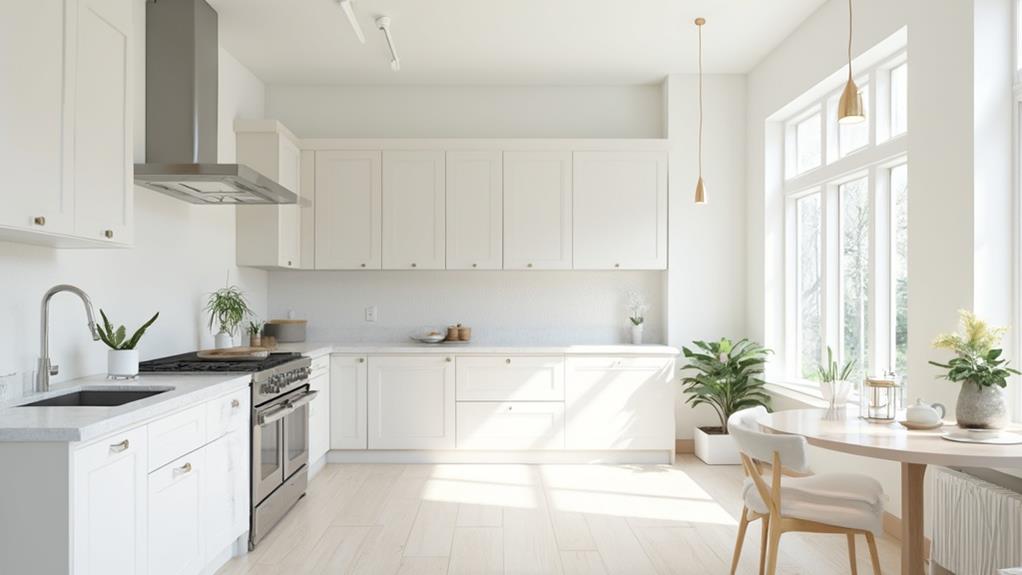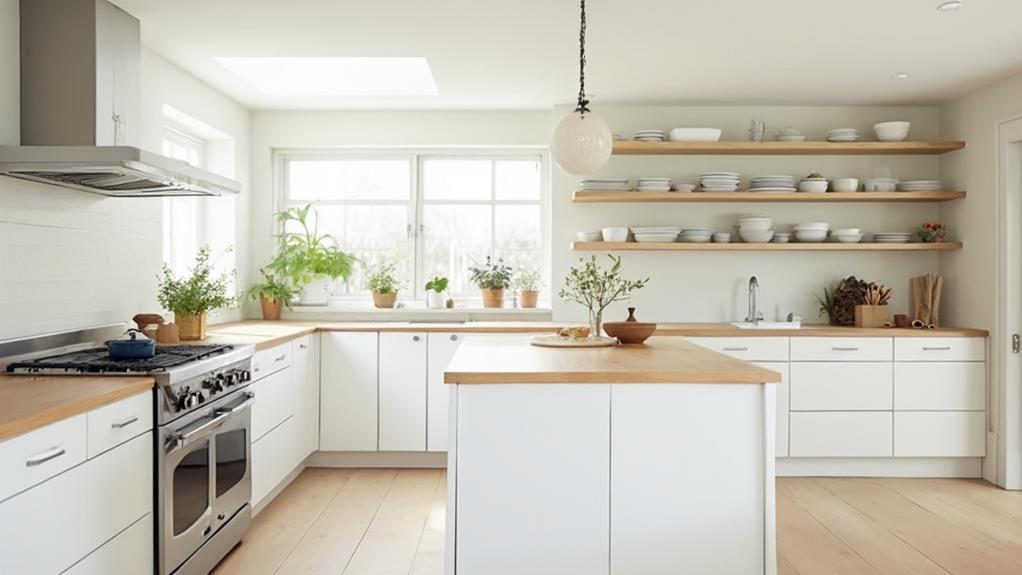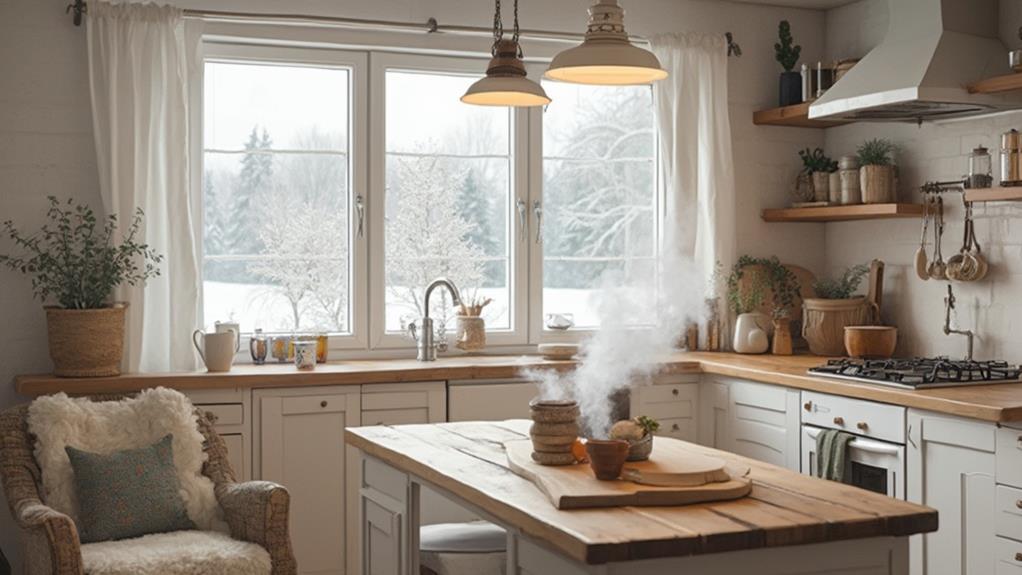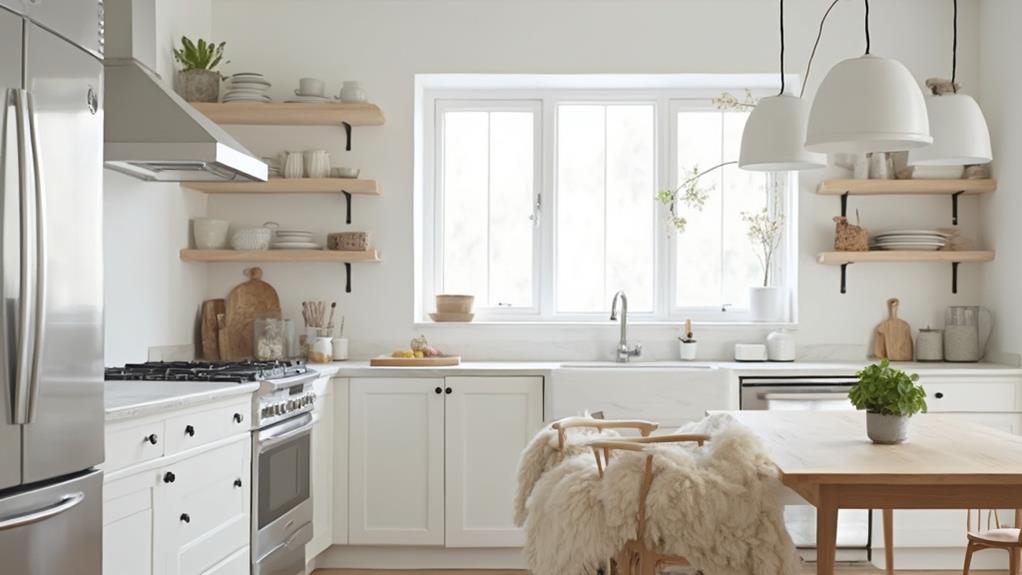To create a Scandinavian-inspired kitchen, focus on maximizing natural light and embracing simplicity. Choose a light color palette for walls, cabinets, and countertops, incorporating natural materials like light-colored woods and stone. Opt for a functional layout with efficient storage solutions, including open shelving and minimalist hardware. Keep the color scheme predominantly white, complemented by soft, muted tones and touches of black or charcoal. Add hygge elements through cozy textiles, ambient lighting, and personal touches. Don't forget to incorporate plants and natural fabrics to enhance the connection to nature. By following these principles, you'll transform your kitchen into a serene and inviting Scandinavian-style space.
Embracing Light and Simplicity

Scandinavian-inspired kitchens invariably embrace light and simplicity. To achieve this aesthetic, start by maximizing natural light. Install large windows or skylights if possible, and opt for sheer or light-colored window treatments.
Choose a light color palette for your walls, cabinets, and countertops, focusing on whites, soft grays, and pale woods.
Keep your kitchen clutter-free by incorporating ample storage solutions. Utilize sleek, handle-less cabinets and open shelving to maintain a minimalist look. Select streamlined appliances that blend seamlessly with your cabinetry. Opt for simple, functional fixtures like stainless steel or matte black faucets and hardware.
Incorporate natural elements to add warmth and texture. Consider wooden flooring, butcher block countertops, or a wooden dining table. Use plants sparingly as accents to bring life to the space without overwhelming it.
For lighting, combine recessed lights with pendant lamps featuring clean lines and simple shapes. Choose materials like glass, metal, or wood for your light fixtures to maintain the Scandinavian aesthetic. Remember, the key is to create a bright, airy space that feels both inviting and uncluttered.
Natural Materials in Focus
Building on the concept of simplicity, natural materials play a central role in Scandinavian kitchen design. You'll find an abundance of wood, stone, and other organic elements that bring warmth and texture to the space. Opt for light-colored woods like pine, birch, or oak for cabinetry, flooring, and countertops. These materials not only look beautiful but also contribute to the overall sense of calm and connection to nature.
Consider incorporating natural stone, such as marble or granite, for countertops or backsplashes. These materials add visual interest while maintaining the clean aesthetic. For a more budget-friendly option, you can use quartz that mimics natural stone patterns.
Don't forget about textiles. Add warmth with natural fabrics like linen or wool for curtains, upholstery, or kitchen towels. These materials provide a cozy touch and help absorb sound in the space.
To complete the look, introduce plants or herbs in simple pots. They'll add a pop of color and life to your kitchen while reinforcing the connection to nature that's so crucial in Scandinavian design.
Functional Layout and Storage

Every Scandinavian-inspired kitchen prioritizes functionality and efficient use of space. To achieve this, you'll want to focus on creating a practical layout that maximizes workflow and storage.
Start by implementing the classic work triangle, positioning your sink, stove, and refrigerator in a triangular arrangement for easy movement between these key areas.
Incorporate plenty of built-in storage solutions to keep your countertops clutter-free. Consider installing floor-to-ceiling cabinets to make the most of vertical space. Opt for drawers instead of lower cabinets, as they offer better accessibility and organization. Don't forget to include pull-out pantry shelves and corner cabinet organizers to utilize every inch of space efficiently.
Open shelving is another hallmark of Scandinavian design. Use it to display everyday items and add visual interest to your kitchen. For a cohesive look, choose sleek, minimalist hardware for your cabinets and drawers.
Minimalist Color Palette
While functionality is key, the color palette plays a vital role in achieving the Scandinavian aesthetic. You'll want to focus on a minimalist approach, using predominantly light, neutral colors to create a bright and airy atmosphere. White is the cornerstone of this style, often used for walls, cabinets, and countertops to maximize natural light reflection.
Complement white with soft, muted tones like light grays, pale blues, or gentle beiges. These colors add depth without overwhelming the space. For contrast, incorporate touches of black or charcoal in hardware, lighting fixtures, or small appliances. This creates visual interest and anchors the design.
Wood tones are essential in Scandinavian kitchens, adding warmth and natural texture. Opt for light to medium wood finishes in flooring, open shelving, or accent pieces. You can also introduce subtle pops of color through accessories or artwork, but keep these elements minimal and intentional.
Incorporating Hygge Elements

Beyond aesthetics and functionality, Scandinavian kitchen design embraces the concept of hygge, a Danish term that encapsulates coziness, comfort, and contentment. To incorporate hygge elements into your kitchen, focus on creating a warm and inviting atmosphere.
Start by adding soft textiles like plush rugs, cozy cushions, and warm throw blankets to seating areas. These tactile elements instantly make the space more welcoming and comfortable.
Introduce natural materials such as wooden cutting boards, woven baskets, and ceramic tableware to bring a sense of earthiness and authenticity. Incorporate ambient lighting with pendant lamps, candles, or string lights to create a soft, warm glow. Display cherished items like family heirlooms or handmade pottery to add personal touches and create a sense of nostalgia.
Don't forget about the power of scent – use essential oils, fresh herbs, or baked goods to fill your kitchen with comforting aromas. Create a dedicated nook for enjoying your morning coffee or tea, complete with a comfortable chair and a view of nature if possible. By incorporating these hygge elements, you'll transform your kitchen into a cozy retreat that encourages relaxation and meaningful connections with family and friends.
Conclusion
You've embarked on a Nordic odyssey, transforming your kitchen into a Scandinavian sanctuary. Like Odin's great hall, your space now radiates warmth and simplicity. You've woven together light, natural materials, and clever storage, creating a tapestry of functionality and style. With a minimalist palette and touches of hygge, you've crafted a kitchen that's not just a place to cook, but a haven where memories are made and shared. Skål to your new culinary kingdom!

